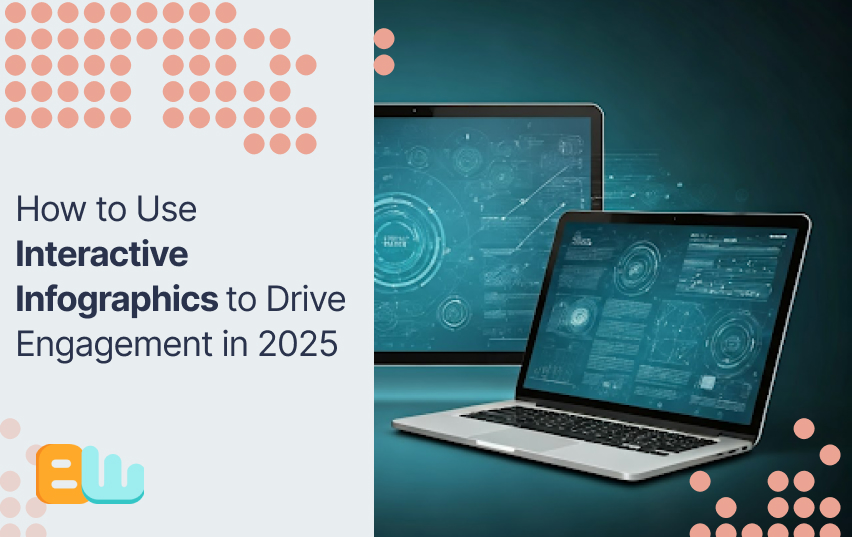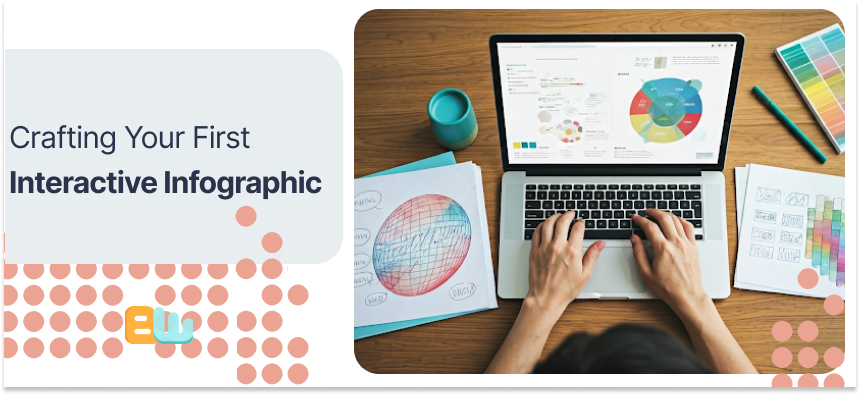
In the changing world of content marketing, grabbing and holding your audience’s attention is essential. That’s where interactive content comes in. This exciting method helps users engage better with information. Unlike static content, interactive content encourages users to participate actively, creating a more memorable user experience. You can use quizzes, polls, or interactive infographics to engage your target audience. Adding interactive elements can help you enhance your content marketing and see better results.
Understanding Interactive Infographics

Interactive infographics are a fresh way to share visual content. They mix striking images with fun ways for users to join in. Instead of just reading information, people can interact and see data visualization. This choice boosts the experience, making details easier to remember and understand.
Imagine this: Would you prefer to read about the world’s tallest buildings or use a lively infographic? The infographic lets you easily compare heights, styles, and building times by clicking or hovering, making the experience more engaging and memorable for viewers.
The Evolution of Infographics in Digital Marketing
Infographics are essential in digital marketing. They help present complicated information in a clear and fun way. However, as digital marketing strategies change, infographics also change. People now want more engaging and interactive content, which has led to the development of dynamic visuals instead of static images.
People use content differently now. In our fast-paced digital world, they look for experiences that capture their attention. Engaging content is essential to meet this demand. Interactive infographics are becoming more popular. They allow users to take part in how they consume content. This method improves user experience.
Key Characteristics of Interactive Infographics
Interactive infographics differ from static ones because they include features that help users engage more efficiently. This makes complex data easier to understand. Let’s look at the key parts of these infographics:
- Dynamic Visualizations: Interactive infographics use animations, transitions, and charts to show data in a fun and creative way.
- Personalized Experiences: These infographics often let users enter their information or choose their path through the content, making them feel more personal.
- Gamification and Rewards: Some infographics include quizzes and challenges, which make them more fun for users and give them a sense of success.
Why Interactive Infographics Capture Audience Attention

Interactive infographics are a powerful tool for content creators. They help grab the attention of their target audience and boost user engagement. What makes these infographics effective is their ability to change how we use content. Instead of just reading information, users can actively explore and enjoy the details.
These infographics let people interact with what they see, which suits different learning styles and tastes. Focusing on how individuals learn helps users understand more clearly, making the information stick better and have a stronger impact.
Enhancing User Engagement through Interactivity
Interactive infographics focus on user interaction. They promote active participation, keeping users engaged in ways that regular visuals do not. For example, reading a list of numbers is different than exploring the same data through an interactive chart. The chart can show trends and patterns quickly.
Interactive features let users participate in the story, making the experience more memorable. Interactive infographics meet personal preferences by allowing people to explore data at their own pace. This improves understanding and helps people remember information better.
The Role of Visuals in Retaining Viewer Interest
Visual elements are essential in interactive infographics. They help users stay engaged and remember the information better. When we see something, our brains process visuals much faster than text. Studies say we can understand visual content 60,000 times quicker.
Interactive infographics transform boring data into exciting visuals. They combine eye-catching pictures, icons, and animations with interactive features to simplify complex data, making it easier to understand and more enjoyable to explore. Bright images also catch viewers’ attention, making them want to look at the infographic more. This allows them to absorb the information better.
Crafting Your First Interactive Infographic

Creating effective interactive infographics requires a smart plan. You must combine great visuals, valuable data, and easy-to-follow design principles. Luckily, many interactive tools and platforms are available now. These tools help content creators more easily turn their ideas into reality.
Also, remember that a good interactive infographic is a powerful tool for lead generation. Adding calls to action and forms to gather information can attract more users. This engaging style will help grow your audience and maximize your efforts.
Selecting the Right Tools and Platforms
Choosing the right interactive tools is essential for creating engaging infographics that fit your content strategy and marketing efforts. With so many options, consider how easy they are to use, the customization features, and the interactive elements you want. This will help you make a wise choice.
If you are new to interactive design, look for user-friendly platforms. Many offer drag-and-drop features and pre-designed templates, which can make learning easier. For example, Canva has a simple design interface with elements that help even those without much design experience. If you are more experienced, you might prefer advanced tools that give you more control over your designs.
Design Principles for Interactive Infographics
Creating effective interactive infographics means using important design rules. These rules focus on clarity, user experience, and good visual appeal. When you follow these best practices, you can make infographics that are fun to use and provide lots of information.
Start with clear and simple messages. This will help you avoid giving too much text or data. Use visual hierarchy to help your audience see the information quickly. This way, they can understand it step by step without confusion. Your interactive infographics should be easy to explore and use. Use clear visual hints, like arrows or buttons, to help users find their way around. Testing with real users during the design process is also a good idea.
Integrating Interactive Infographics into Your Content Strategy

Interactive infographics should fit well into your content strategy. Don’t think of them as separate pieces. Instead, see how they can enhance your digital content and marketing strategies.
For instance, adding an interactive infographic to a blog post or social media campaign can boost engagement and reach. You can also place these infographics on landing pages or email marketing teams to improve user experience and help get more conversions.
Identifying Goals and Target Audience
Before starting your design, knowing your goals and target audience is essential. Think about what you want to accomplish with your interactive infographic. Are you trying to get leads, build brand awareness, or teach your audience about something specific?
To create content that connects, you need to understand your target audience and what they like. Look at details like age, interests, and online behavior. Knowing your audience helps you adjust your infographic’s message, tone, and style to fit their needs. When your infographic matches your target audience’s interests and connects to your content marketing goals, you can maximize its impact.
Content Planning and Distribution Channels
Think about your content strategy. It’s important to pick distribution channels that match your target audience and goals. Will you share your infographic mainly on social media? Will it be inside a blog post or email marketing plan?
Different distribution channels have their benefits and must be set up well for the best results. For instance, social media likes visual content that is easy to share. On the other hand, email campaigns need simple messages and strong calls to action.
SEO Strategies for Interactive Infographics

Optimizing your interactive infographic for search engines is very important. This helps you drive organic traffic and ensures more people see your work. Even if the interactive parts are fun for users, search engines focus on how easy your content is to find and understand. Using good SEO strategies can help your infographic place higher and reach more people.
Start by researching keywords that are important to your target audience. Find out what terms they use the most. Next, use these keywords in your infographic’s title, headings, and main text. This will help your infographic show up better in search results. Don’t forget to improve the infographic’s metadata, too. Ensure the title tag and meta description fit your content well and make users want to click on them.
Incorporating Keywords and Meta Descriptions
Keywords help search engines find and understand what your infographic is about. By using relevant keywords in the text of your infographic, you help search engines index and rank your content better. This boosts visibility and helps more people discover your work.
Creating a strong meta description is also crucial. This summary of the infographic appears in search results. A good meta description encourages users to click by showing the value of your infographic. It should include important keywords to help it rank higher in search results. The key is to find a good balance. You need to optimize for keywords while ensuring the information flows well and is engaging.
Building Backlinks through Shareable Content
Backlinks are links from other websites to your infographic. They matter a lot for search engines. Backlinks tell these engines that your content is good and trusted. To get more backlinks, you should make high-quality and shareable content.
Social media is very important for promoting your content. Fun and engaging social media posts can showcase key points or interesting images from your infographic, helping it reach more people and be shared more often.
You can also connect with bloggers, journalists, and industry leaders who may like your infographic. Giving them embed codes makes it easier for them to share your infographic on their sites. This helps grow its reach and increases the chance of getting more backlinks.
Future Trends in Interactive Infographics

Content creators need to keep up with new technologies and trends in the fast-changing digital landscape. Interactive infographics are a big part of this, enhancing user engagement. As we consider what’s next, many predictions of this engaging type of content exist.
We can expect many exciting changes, including personalization using AI and immersive experiences. The future of interactive infographics looks bright and will rely more on data, which will help make it more captivating and better for users.
Emerging Technologies and Their Impact
Emerging technologies promise to reshape the landscape of interactive infographic design in the coming years. Integrating artificial intelligence (AI), augmented reality (AR), and virtual reality (VR) can enhance user experience by creating genuinely immersive and personalized journeys through data.
Interactive video content, for instance, allows users to engage with video footage in an entirely new way, manipulating elements or choosing their adventure. Similarly, shoppable videos transform e-commerce by enabling viewers to purchase directly within the video player, blurring the lines between content and commerce.
Predictions for Interactive Content in 2025
The digital landscape will continue to change between 2025 and beyond, affecting how we create and consume content. Interactive content will remain important, adapting to new technologies and user preferences. Hyper-personalization will play a big part in creating interactive content. As AI and machine learning improve, content creators will create personalized experiences that match user preferences, backgrounds, and behavior patterns.
This personalized interactive content helps users find information that fits their needs and interests. This will keep them engaged and lead to more conversions. Interactive infographics and other marketing tools will help marketers create more focused and effective campaigns.
Conclusion
Interactive infographics are the future of fun content. They grab attention and keep people interested like never before. You can boost user experience by adding interactive parts, eye-catching visuals, and smart SEO strategies. To create your first interactive infographic, choose the right tools. Make sure to design it to get users engaged. Also, fit it into your content strategy. This should help you reach your goals and focus on your target audience. Looking ahead to 2025, technology will keep changing interactive infographics. They will become a key tool for grabbing people’s attention and improving content marketing efforts. Use interactive infographics to boost engagement and stay on top of the digital landscape.
